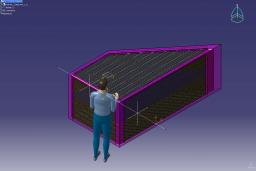DESCRIPTION OF THE PROJECT
Physics and programmes:
Innovation for detection systems/Detector developments
Nuclear matter in its extreme states / Exotic nuclei
Goals of the project
The construction of a new multi-track charged particle detector is necessary for the experiments which will be performed in the R3B hall of the future FAIR facility and which will require the detection of multi-charged particle final states after the magnetic analysis provided by the future GLAD spectrometer such as spallation, fission or proton or alpha decay reactions.
The spallation group of the Service de Physique Nucléaire (SPhN) is involved in two projects of experiments for R3B which will need the detection of such final states:
- the study of heavy nuclei spallation, in coincidence and inverse kinematics, such as lead-208 (208Pb) or uranium-238 (238U),
- The study in coincidence of fission of minor actinides which have undergone coulomb excitation in the electrostatic field of a heavy nucleus.
The aim of such a multi-track detector is three-fold:
- To detect efficiently all types of charged fragments and particles, from proton to uranium, i.e. on a dynamic range of the ionisation signals of 1 : 104,
- To identify unambiguously the charge of each particle or fragment (at 1 GeV per nucleon kinetic energy, the nuclear fragments are completely stripped so that their electrical charges, which can be measured by detectors, are their atomic number, i.e. the charges of the nuclei),
- To determine precisely the geometry of the particle tracks in 3D (two angles and three coordinates) in order to allow the determination of their masses and the reconstruction of their kinematics at the reaction point after the numerical inversion of the magnetic transport within GLAD.
This three-fold aim must be reached in order to have a complete reconstruction, event by event, of the nuclear reaction kinematics at the target point. Such a reconstruction is the common goal of all the experiments to be performed within the R3B collaboration even though the nuclear physics domains explored there will be relatively different. This reconstruction will permit to determine the characteristics of the excited nucleus which is the intermediate state between the initial state (the projectile and the target nucleus) and the final state, after the complete de-excitation of the system.
The construction of a new detector is made necessary by the planned characteristics of the future GLAD magnet. In fact, its characteristics (angular aperture, momentum acceptance, bending power and physical dimensions of the device) will produce larger envelopes of the particle tracks at the exit of the magnet, with larger angles with respect to the GLAD magnet symmetry axis, as compared with the existing facility of the ALADIN magnet (GSI, Cave C). The detector used now by the spallation group of SPhN, which is the time projection chamber (TPC) MUSIC 4 (Link to KP3 web site) will indeed not be appropriate for the future experiments in the R3B hall.
The concept of time projection chamber was chosen, as for MUSIC 4, because this type of detector is relatively cheap to build as compared to other detectors. Furthermore, its performances will be within the requirements of the future experiments of R3B without major R&D efforts and can be easily adapted to different experimental conditions, for both low and high multiplicities in the final states.
Size of the project
- Investment: around 600 k€ over the duration of the project (4 to 5 years)
- Staff: roughly 15 person.year over the duration of the project
CONTACTS
Scientific leader : Jean-eric DUCRET
TPC design study leader : Philippe LEGOU




